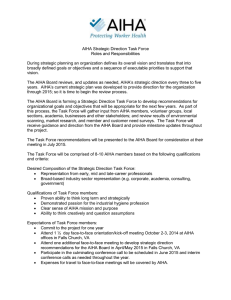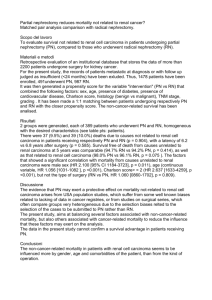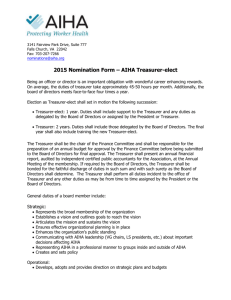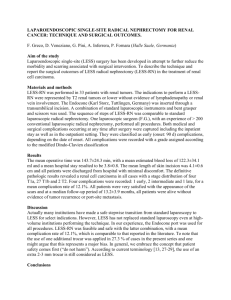Autoimmune hemolytic anemia associated with renal urothelial cancer: A case report
advertisement
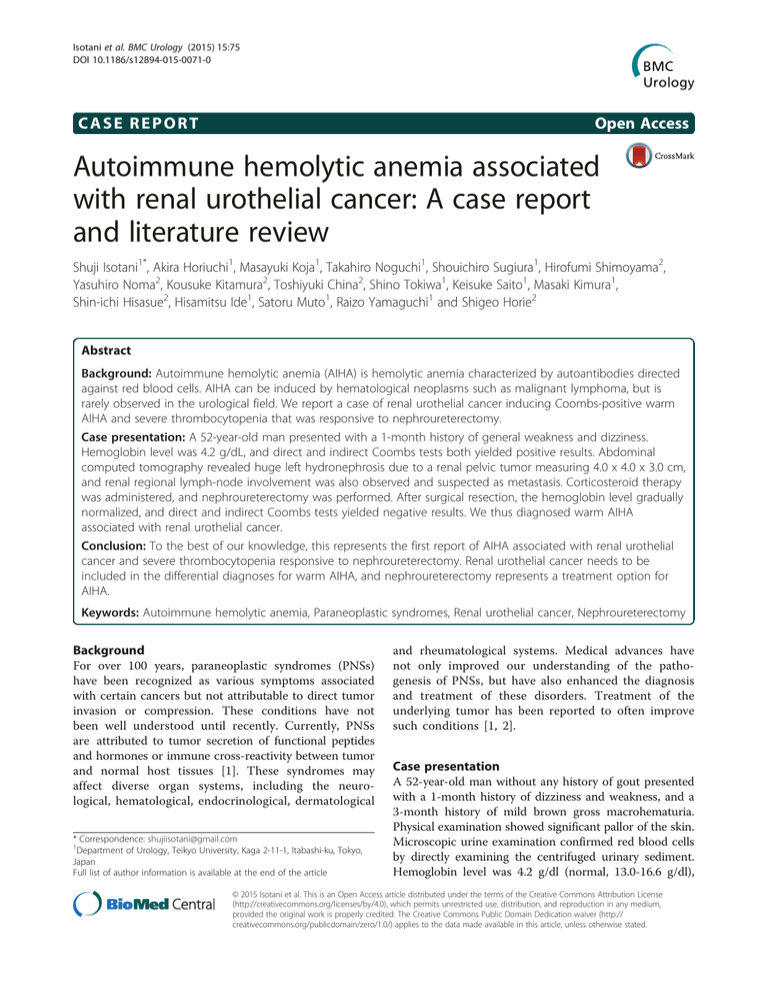
Isotani et al. BMC Urology (2015) 15:75 DOI 10.1186/s12894-015-0071-0 CASE REPORT Open Access Autoimmune hemolytic anemia associated with renal urothelial cancer: A case report and literature review Shuji Isotani1*, Akira Horiuchi1, Masayuki Koja1, Takahiro Noguchi1, Shouichiro Sugiura1, Hirofumi Shimoyama2, Yasuhiro Noma2, Kousuke Kitamura2, Toshiyuki China2, Shino Tokiwa1, Keisuke Saito1, Masaki Kimura1, Shin-ichi Hisasue2, Hisamitsu Ide1, Satoru Muto1, Raizo Yamaguchi1 and Shigeo Horie2 Abstract Background: Autoimmune hemolytic anemia (AIHA) is hemolytic anemia characterized by autoantibodies directed against red blood cells. AIHA can be induced by hematological neoplasms such as malignant lymphoma, but is rarely observed in the urological field. We report a case of renal urothelial cancer inducing Coombs-positive warm AIHA and severe thrombocytopenia that was responsive to nephroureterectomy. Case presentation: A 52-year-old man presented with a 1-month history of general weakness and dizziness. Hemoglobin level was 4.2 g/dL, and direct and indirect Coombs tests both yielded positive results. Abdominal computed tomography revealed huge left hydronephrosis due to a renal pelvic tumor measuring 4.0 x 4.0 x 3.0 cm, and renal regional lymph-node involvement was also observed and suspected as metastasis. Corticosteroid therapy was administered, and nephroureterectomy was performed. After surgical resection, the hemoglobin level gradually normalized, and direct and indirect Coombs tests yielded negative results. We thus diagnosed warm AIHA associated with renal urothelial cancer. Conclusion: To the best of our knowledge, this represents the first report of AIHA associated with renal urothelial cancer and severe thrombocytopenia responsive to nephroureterectomy. Renal urothelial cancer needs to be included in the differential diagnoses for warm AIHA, and nephroureterectomy represents a treatment option for AIHA. Keywords: Autoimmune hemolytic anemia, Paraneoplastic syndromes, Renal urothelial cancer, Nephroureterectomy Background For over 100 years, paraneoplastic syndromes (PNSs) have been recognized as various symptoms associated with certain cancers but not attributable to direct tumor invasion or compression. These conditions have not been well understood until recently. Currently, PNSs are attributed to tumor secretion of functional peptides and hormones or immune cross-reactivity between tumor and normal host tissues [1]. These syndromes may affect diverse organ systems, including the neurological, hematological, endocrinological, dermatological * Correspondence: shujiisotani@gmail.com 1 Department of Urology, Teikyo University, Kaga 2-11-1, Itabashi-ku, Tokyo, Japan Full list of author information is available at the end of the article and rheumatological systems. Medical advances have not only improved our understanding of the pathogenesis of PNSs, but have also enhanced the diagnosis and treatment of these disorders. Treatment of the underlying tumor has been reported to often improve such conditions [1, 2]. Case presentation A 52-year-old man without any history of gout presented with a 1-month history of dizziness and weakness, and a 3-month history of mild brown gross macrohematuria. Physical examination showed significant pallor of the skin. Microscopic urine examination confirmed red blood cells by directly examining the centrifuged urinary sediment. Hemoglobin level was 4.2 g/dl (normal, 13.0-16.6 g/dl), © 2015 Isotani et al. This is an Open Access article distributed under the terms of the Creative Commons Attribution License (http://creativecommons.org/licenses/by/4.0), which permits unrestricted use, distribution, and reproduction in any medium, provided the original work is properly credited. The Creative Commons Public Domain Dedication waiver (http:// creativecommons.org/publicdomain/zero/1.0/) applies to the data made available in this article, unless otherwise stated. Isotani et al. BMC Urology (2015) 15:75 and mean corpuscular volume (MCV) was 88.2 fl with elevated white blood count (14.7 × 109/l) and normal platelet count (38.0 × 109/l). Absolute reticulocyte counts were 1.1 thou/μL. Prothrombin time and activated partial thromboplastin time were both within normal ranges. The serum haptoglobin level was 15 mg/dL. Lactate dehydrogenase level was elevated to 325 IU/L (normal, 119– 229 IU/L). Serum level of total bilirubin was markedly elevated to 4.85 mg/dL (normal, 0.0-1.1 mg/dL), whereas direct bilirubin level was only slightly elevated (0.5 mg/dL; normal, 0.0-0.4 mg/dL). Iron studies showed that B12 level was markedly elevated to 6030 pg/ml (normal, 249– 938 pg/ml), whereas folate level was normal. Serum immunoglobulin (Ig) levels were normal, and electrophoresis revealed no abnormal bands. A direct Coombs test showed positive results for IgG and negative results for complement C3, while an indirect Coombs test for antiglobulin also yielded positive results. Testing to exclude other autoimmune diseases showed that antinuclear antibodies, antibodies to double-stranded DNA, and antiphospholipid antibodies were all negative. Levels of various tumor markers (prostate-specific antigen, neuron-specific enolase, alphafetoprotein, carbohydrate antigen 19–9, carcinoembryonic antigen, squamous cell carcinoma (SCC) antigen were examined and found to be within normal limits. However, serum interleukin (IL)-2 receptor level was elevated to 1503 U/ml (normal, 145–519 U/ml). Urine cytology was negative for cancer. Abdominal computed tomography and magnetic resonance imaging revealed huge left hydronephrosis due to a renal pelvic mass measuring 4.0 × 4.0 × 3.0 cm, and renal regional lymphnode involvement was also observed as a 2-cm mass, which was suspected to represent metastasis of a renal urothelial cancer or malignant lymphoma extension with renal involvement. A diagnosis of IgG-mediated warm autoimmune hemolytic anemia (AIHA) was made on hospital day 3. The patient was transfused with crossmatch-compatible blood. Oral corticosteroid therapy (prednisolone, 60 mg/day) and intravenous Igs 500 mg/day for 3 days were also administered after diagnosis and achieved limited improvement. Surgical treatment was performed on hospital day 7, since tumors that induce AIHA are usually hematological neoplasms such as malignant lymphoma. We planned to eliminate the possibility of malignant lymphoma intraoperatively by intraoperative frozen section diagnosis. If the results of intraoperative biopsy revealed malignant lymphoma of the kidney, initiating chemotherapy as treatment would be considered. Conversely, if some other malignant epithelial tumor was identified, such as renal urothelial cancer or renal cell carcinoma, nephroureterectomy was planned as surgical treatment. The results of intraoperative biopsy indicated reactive hyperplasia of the lymph node, rather Page 2 of 5 than malignant lymphoma. We therefore consecutively performed left nephroureterectomy as a treatment for AIHA. After surgical resection of the left kidney, hemoglobin level and reticulocyte count gradually normalized. Direct and indirect Coombs tests yielded negative results by 7 post-operative weeks. At 10 weeks after surgery, complete blood counts had recovered to within normal ranges and the dose of prednisolone was tapered to 15 mg/day after 10 weeks (Fig. 1). The diagnosis was confirmed to be warm AIHA associated with renal urothelial cancer. The specimen of the left kidney showed papillary urothelial carcinoma (UC) in the renal pelvis with undifferentiated carcinoma, G2, pT4, INF γ, lt-u0, ew1, ly1, v1, n2), and gradual invasion of the tumor into the renal parenchyma with change to undifferentiated carcinoma. Multiple lung and liver metastases were observed 3 months postoperatively on a CT of the chest and abdomen, so the prednisolone dose was increased to 20 mg/day from 14 weeks to prevent recurrence of AIHA. No symptoms of AIHA or abnormal hemolytic state were observed. Prednisolone was tapered to 5 mg/day and the dosage kept unchanged at 5 mg/day. Although chemotherapy using gemcitabine plus cisplatin for metastases was administered, the patient died 7 months after surgery due to rapid development of metastases and multiple-organ failure (MOF). Discussion Anemia frequently complicates the course of cancer and causes fatigue, representing a very common symptom associated with cancer patients and negatively impacting activities of daily living and quality of life, sometimes becoming life-threating in itself. Some types of anemia associated with cancer involve hematological autoimmune disease, such as AIHA. AIHA is a condition characterized by autoantibodies directed against the red blood cells. Most cases of AIHA are idiopathic, but AIHA can be secondary to some malignancies [3, 4]. These immunemediated hematological diseases are not usual, but are known as a typical PNS. In the literature, AIHA as a PNS has been demonstrated in patients with a wide variety of tumors, including hematological neoplasms such as malignant lymphoma, squamous cell carcinoma, adenocarcinoma, renal cell carcinoma, oat cell carcinoma and seminoma [4, 5]. However, renal malignancy is rarely associated with hematological PNS, and we have not identified any reports of AIHA associated with renal urothelial cancer. We examined the literature for AIHA associated with renal tumor, and the results are summarized in Table 1 [1, 3, 5–8]. AIHA secondary to a paraneoplastic process of renal tumor has been reported in association with severe anemia that can lead to significant morbidity and even mortality [7]. From this perspective, correct Isotani et al. BMC Urology (2015) 15:75 Page 3 of 5 Fig. 1 Clinical course of AIHA associated with renal urothelial cancer diagnosis of AIHA as a PNS and start of treatment as soon as possible is very important. The diagnosis of paraneoplastic AIHA should be made after ruling out metastases, infections, metabolic processes, and vascular alterations. In this case, we diagnosed paraneoplastic AIHA on day 3 of admission and started treatment, performing surgery on day 7. With that clinical decision, given the disadvantage that this case seems to represent the first report of AIHA with renal urothelial cancer, the literature helped us to determine which treatment might be most suitable, even though the pathogenic mechanisms underlying the association between carcinoma and autoimmune hemolytic disease remain poorly understood. The pathogenesis of these PNSs involves the release of substances with endocrine and metabolic activity by tumor cells, or induction of the release of inflammatory mediators, principally cytokines such as interleukin (IL). IL-6 has been identified as being responsible for some inflammatory processes [4]. In this case, such mediators were suggested to be secreted from cancer cells based on blood analysis finding abnormal elevations of the white blood count, B12 level, and serum IL-2 receptor level on admission. These findings also supported our diagnosis of AIHA as a PNS in this case. Steroids represent the major therapy for idiopathic AIHA. Steroid-resistant cases may require splenectomy, although more recently other immunosuppressants such as azathioprine, mycophenolate, the monoclonal antibody rituximab, and intravenous immunoglobulins have been successfully applied. Control of the carcinoma through tumor excision or chemotherapy with corticosteroid therapy and/or splenectomy might improve hematological abnormalities [8]. In fact, most reports with renal tumor seem to have described nephrectomy as an effective treatment for AIHA and renal carcinoma [1, 3, 5–8]. In our case, we performed nephroureterectomy to control the AIHA rather than the cancer. Surgical treatment improved the hemolytic state for at least 7 months, even though cancer control failed, with multiple metastases appearing in the liver and lungs within 3 months. We considered increasing the prednisolone dose from 15 mg/day to 20 mg/day to prevent the recurrence of AIHA, because we thought that recurrence of the carcinoma might initiate the hematological abnormalities. If the tumor started to progress, AIHA would thus presumably recur. However, no AIHA symptoms were observed, with negative Coombs reactions observed until the patient died of MOF. This result suggests that once control of AIHA was initiated by surgical intervention, control could be maintained with steroid therapy alone. Conclusions We have reported a case of warm AIHA as a PNS with renal urothelial cancer. Hemolytic anemia as a PNS is diagnosed by excluding other causes such as primary hematological alterations, metastasis, and vascular Isotani et al. BMC Urology (2015) 15:75 Page 4 of 5 Table 1 Contemporary series of AIHA associated with renal tumor References Age/Sex Hb Stage, Pathology Cooms test (Direct/Indirect) Treatment Response to Treatment Outcome Pirofsky B (1968) 65/M Ht:26% non-metastatic positive/positive steroid CR NA Spira MA (1979) 68/F 8.7 CR recurrence-free RCC and RCC hypernephroma nephrectomy positive/positive (IgG) steroid nephrectomy AIHA for 5 years splenectomy Bradley G (1981) 57/F 6.8 non-metastatic positive/positive steroid clear cell RCC Non-specific nephrectomy CR died with lung metastasis after 17 months with AIHA lymph-node metastasis, positive/positive steroid CR NA T3b positive/positive steroid CR clear cell RCC (IgM) nephrectomy DAT remained positive, no follow-up data T1N0M0 negative/positive nephrectomy CR sustained CR of RCC and AIHA for 2+ years positive steroid CR NA CR NA nephrectomy CR NA CR died with multiple metastases after 7 months without AIHA (only IgG negative) Venzano C (1985) 71/F 7.5 Girelli G (1988) 39/M 4.0 Monga M (1995) 38/F Lands R (1996) 65/M 8.1 Kamra D (2002) 68/F 5.6 renal cell carcinoma renal cell cancer T3a adenocarcinoma T2N0M0 nephrectomy negative steroid clear cell RCC globulin therapy nephrectomy Muñoz-Ibarrav EL (2013) 71/F Our case (2015) 52/M 6.7 T1aN0M0 positive steroid clear cell RCC 3.2 T4N2M0 positive/positive steroid UC+RCC (IgG) globulin therapy nephrectomy processes. The appearance of unusual hematological alterations in patients with renal tumor should be suspected with these hematological paraneoplastic alterations. Our experience suggests that hemolytic anemia as a PNS should be considered in patients with hematological alterations with renal urothelial cancer, and if confirmed, surgical intervention with steroid administration should be considered. Consent Written informed consent was obtained from the patient for publication of this case report and the accompanying images. A copy of the written consent is available for review by the editor of this journal. Authors’ contributions All authors participated in this case. All authors read and approved the final manuscript. Authors’ information Qualifications: MD. and Ph.D. Title: Assistant Professor. Affiliations: Department of Urology, School of Medicine, Teikyo University, Tokyo, Japan. Acknowledgements The authors gratefully acknowledge the contribution of Dr. Kazuo Kawasugi and Dr. Naoki Shirafuji of the Department of Hematology. They also thank the staff of the Teikyo Hospital urology unit. Financial disclosure No financial support was received in relation to this article. Abbreviations AIHA: Autoimmune hemolytic anemia; PNS: Paraneoplastic syndromes; MOF: Multiple-organ failure; UC: Urothelial carcinoma; IL: Interleukin. Author details 1 Department of Urology, Teikyo University, Kaga 2-11-1, Itabashi-ku, Tokyo, Japan. 2Department of Urology, Juntendo University, Graduate School of Medicine, Tokyo, Japan. Competing interests The authors declare that they have no conflict of interests. Received: 4 March 2015 Accepted: 20 July 2015 Isotani et al. BMC Urology (2015) 15:75 Page 5 of 5 References 1. Lorraine C, Pelosof MD. Paraneoplastic Syndromes: An Approach to Diagnosis and Treatment. Mayo Clin Proc. 2011;85:838–54. 2. Koike H, Yoshida H, Ito T, Ohyama K, Hashimoto R, Kawagashira Y, et al. Demyelinating neuropathy and autoimmune hemolytic anemia in a patient with pancreatic cancer. Intern Med. 2013;52:1737–40. 3. Krauth M-T, Puthenparambil J, Lechner K. Paraneoplastic autoimmune thrombocytopenia in solid tumors. Crit Rev Oncol Hematol. 2012;81:75–81. 4. Visco C, Barcellini W, Maura F, Neri A, Cortelezzi A, Rodeghiero F. Autoimmune cytopenias in chronic lymphocytic leukemia. Am J Hematol. 2014;89:1055–62. 5. Puthenparambil J, Lechner K, Kornek G. Autoimmunhämolytische Anämie, ein paraneoplastisches Phänomen bei soliden Tumoren: Eine kritische Analyse von 52 publizierten Fällen. Wien Klin Wochenschr. 2010;122:229–36. 6. Kamra D, Boselli J, Sloane BB, Gladstone DE. Renal cell carcinoma induced Coombs negative autoimmune hemolytic anemia and severe thrombocytopenia responsive to nephrectomy. J Urol. 2002;167:1395–5. 7. Lands R, Foust J. Renal cell carcinoma and autoimmune hemolytic anemia. South Med J. 1996;89:444–5. 8. Spira MA, Lynch EC. Autoimmune hemolytic anemia and carcinoma: an unusual association. Am J Med. 1979;67:753–8. Submit your next manuscript to BioMed Central and take full advantage of: • Convenient online submission • Thorough peer review • No space constraints or color figure charges • Immediate publication on acceptance • Inclusion in PubMed, CAS, Scopus and Google Scholar • Research which is freely available for redistribution Submit your manuscript at www.biomedcentral.com/submit
